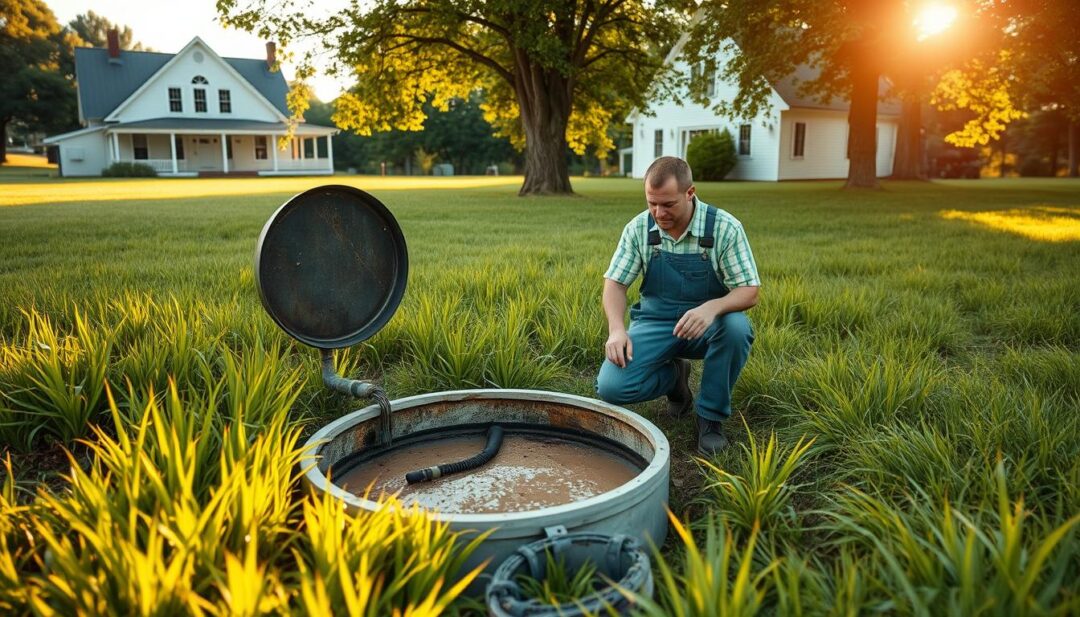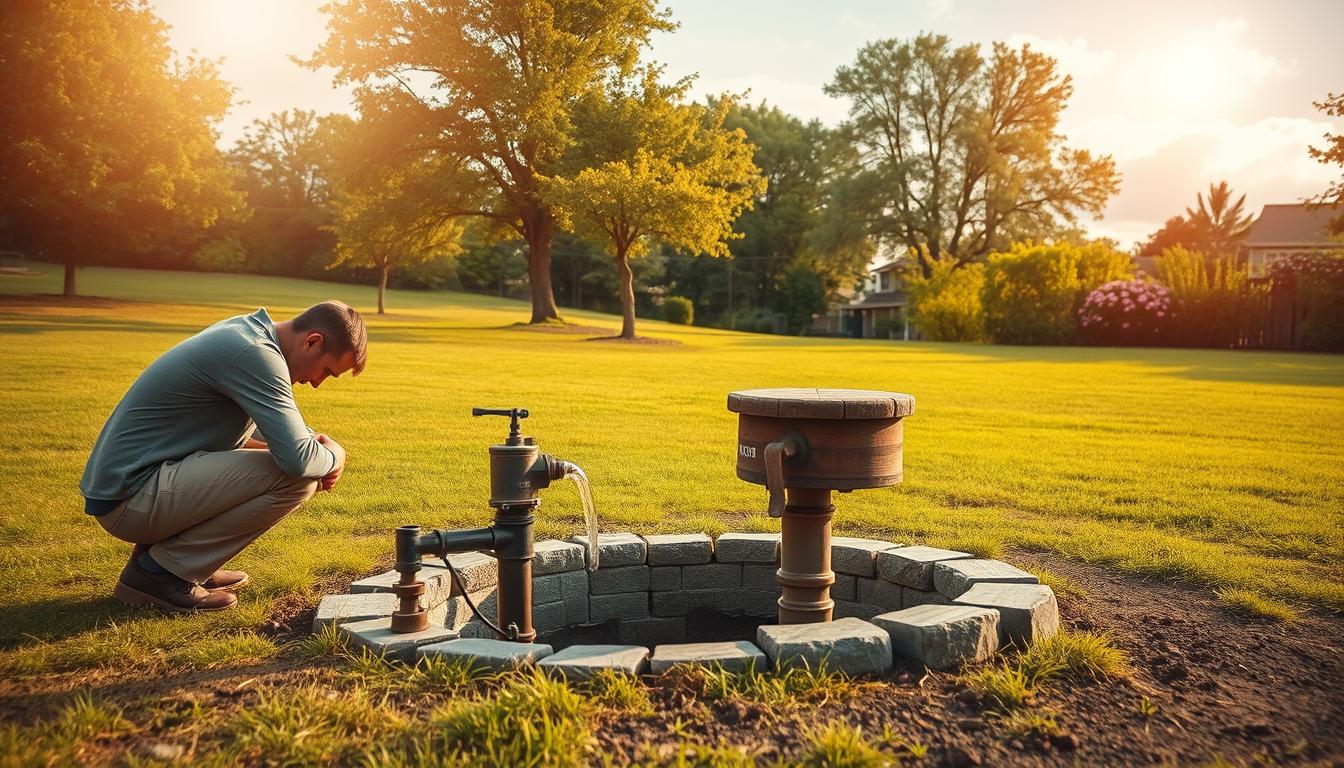Proper Care for Your Private Well and Septic System
Are you aware of the critical role your private well and septic system play in maintaining your household’s health and safety? For many homeowners, especially in rural areas, these systems are a lifeline, providing water and waste management. However, without proper care, they can become a source of contamination and health risks.
Maintaining your septic system and well is not just about avoiding costly repairs; it’s about ensuring the water you drink is safe and free from harmful contaminants. Regular maintenance can help prevent failures that could lead to environmental hazards and health issues.
Key Takeaways
- Regular inspection of your well and septic system is crucial.
- Proper maintenance can prevent water contamination.
- Understanding your system’s components can help in identifying potential issues early.
- Regular pumping of your septic tank is essential for its longevity.
- Testing your well water regularly ensures it’s safe to drink.
Understanding Your Private Well and Septic System
Understanding the mechanics of your private well and septic system is crucial for maintaining a safe and healthy water supply. These systems are vital for households not connected to municipal water and sewage services.
How Private Wells Work
Private wells draw water from underground aquifers. The well construction involves drilling or digging to access water-bearing formations.
Well Components and Construction
A typical well consists of a well casing, a pipe that lines the well and prevents contamination. The casing is usually made of steel or PVC and extends from the surface to the aquifer.
Water Flow and Distribution
Water is pumped from the well to the household through a distribution system. This system includes a pump, pressure tank, and piping. Regular maintenance of these components is essential for reliable water supply.
Components of a Septic System
A septic system treats wastewater from households. It consists of a septic tank and a drain field.
Septic Tank Structure
The septic tank is a watertight container that holds wastewater long enough to allow solids to settle and oil to float to the surface. Regular pumping of the septic tank is necessary to prevent system failure.
Drain Field Function
The drain field, or leach field, is a shallow excavation filled with gravel and a network of perforated pipes. It disperses treated wastewater into the soil, where it is further filtered and purified.
By understanding the components and functions of your private well and septic system, you can better maintain them. Regular well water maintenance and septic system maintenance are key to ensuring a safe and reliable water supply.
The Importance of Regular Maintenance
The importance of regular maintenance for private wells and septic systems cannot be overstated. Regular upkeep ensures these systems operate efficiently and effectively, safeguarding both health and the environment.
Health and Safety Considerations
Maintaining your private well and septic system is crucial for health and safety. Two key aspects to consider are:
- Preventing Contamination: Regular inspections can identify potential issues before they lead to contamination. This includes checking for signs of leakage or damage around the well and septic system.
- Protecting Family Health: By ensuring your water supply is clean and your septic system is functioning correctly, you protect your family from waterborne illnesses. For more information on maintaining a healthy septic system, visit septic tank maintenance.
Financial Benefits of Preventive Care
Regular maintenance also offers significant financial benefits. Key advantages include:
- Avoiding Costly Repairs: Regular inspections can identify issues early, reducing the likelihood of major repairs. This proactive approach can save homeowners significant amounts of money.
- Extending System Lifespan: Proper maintenance can extend the lifespan of both your well and septic systems, delaying the need for costly replacements.
By prioritizing regular maintenance, homeowners can ensure their private well and septic systems remain in good working order, protecting both their health and their investment.
Essential Well Maintenance Practices
To keep your well functioning properly, it’s essential to adopt a routine maintenance schedule. Regular maintenance not only ensures the longevity of your well but also safeguards the quality of your water supply. By following a few key practices, you can prevent common issues and maintain a safe and reliable source of water.
Annual Well Inspection Checklist
An annual inspection is crucial for identifying potential problems before they become major issues. Your inspection should include checking the well cap for any signs of damage or wear, inspecting the casing for cracks or corrosion, and testing the well’s water level and yield. For a comprehensive checklist and more detailed guidance, you can refer to resources like private well maintenance tips.
Protecting Your Well from Contamination
Protecting your well from contamination is vital for maintaining water quality. Ensure that your well is located at a safe distance from potential sources of contamination, such as septic systems, agricultural runoff, and industrial activities. Regularly inspect the surrounding area for any new potential risks and take steps to mitigate them. Additionally, consider having your water tested regularly for contaminants, including those that might not be immediately apparent, such as nitrates or bacteria.
Maintaining Well Components
Regular maintenance of your well’s components is essential for its overall performance. This includes:
Pump Maintenance
The pump is a critical component of your well system. Regularly check the pump’s performance and inspect it for signs of wear or failure. Ensure that the pump is properly sized for your well’s yield and that it’s operating within the recommended parameters.
Well Cap and Casing Care
The well cap and casing are your well’s first line of defense against contamination. Ensure that the cap is securely locked and that the casing is free from cracks and corrosion. Regular inspections can help identify any issues before they lead to more serious problems.
For more information on maintaining your well and identifying potential issues early, you can visit resources on well maintenance. By following these essential maintenance practices, you can help ensure that your private well continues to provide a safe and reliable source of water for years to come.
Proper Care for Your Private Well and Septic System
Ensuring the longevity of your private well and septic system involves a combination of regular inspections and proper care. A well-maintained system is crucial for the health and safety of your household and the environment.
Septic Tank Pumping Schedule
Regular septic tank pumping is essential to prevent system failure. The frequency of pumping depends on several factors, including the size of your tank, the number of people in your household, and your water usage patterns. Typically, a septic tank should be pumped every 3 to 5 years. Neglecting to pump your septic tank can lead to costly repairs and potential health hazards.
- Check your local regulations for specific pumping requirements.
- Keep records of pumping and maintenance activities.
- Consider factors like household size and water usage when determining pumping frequency.
What Not to Flush or Drain
To maintain your septic system’s health, it’s crucial to be mindful of what you flush or drain. Avoid disposing of non-biodegradable items and harsh chemicals, as they can disrupt the biological balance of your septic system. Common items to avoid include:
- Sanitary products and wet wipes
- Chemicals like paint and pesticides
- Excessive amounts of cooking oil and grease
Maintaining the Drain Field
A well-maintained drain field is vital for the proper functioning of your septic system. Two key aspects of drain field maintenance are avoiding compaction and managing vegetation.
Avoiding Compaction
Compaction can damage the drain field’s ability to absorb and filter wastewater. To avoid compaction:
- Keep heavy vehicles and equipment off the drain field.
- Plant grass or other shallow-rooted plants to help distribute the weight.
Managing Vegetation
Vegetation plays a significant role in maintaining the health of your drain field. Regularly inspect and manage the vegetation to ensure it’s not too dense or too sparse.
- Maintain grass cover to prevent erosion.
- Avoid planting trees or deep-rooted plants that can damage the drain field.

Water Quality Testing for Private Wells
Regular water quality testing is a vital step in maintaining a safe and reliable private well. Ensuring your well water is free from contaminants is crucial for the health and well-being of your household.
Recommended Testing Schedule
It is recommended to test your well water at least once a year for bacteria, nitrates, and other contaminants. More frequent testing may be necessary if you notice changes in the taste, odor, or appearance of your water.
- Test for bacteria and nitrates annually
- Check for other contaminants every 3-5 years
- Consider more frequent testing if you have a new neighbor or changes in land use nearby
Common Contaminants to Test For
Private wells can be susceptible to various contaminants, including bacteria, viruses, nitrates, and heavy metals. Testing for these contaminants can help identify potential issues before they become serious health risks.
| Contaminant | Potential Health Risk | Common Sources |
|---|---|---|
| Bacteria (e.g., E. coli) | Gastrointestinal illness | Septic systems, animal waste |
| Nitrates | Blue baby syndrome, cancer risk | Fertilizers, septic systems |
| Heavy Metals (e.g., lead, arsenic) | Neurological damage, cancer | Natural sources, industrial activities |
Understanding Test Results
Once you’ve received your test results, it’s essential to understand what they mean and what actions to take if necessary.
Interpreting Lab Reports
Lab reports will indicate the presence and concentration of various contaminants. Compare these results to established safety standards to determine if your water is safe to drink.
When to Take Action
If your test results show contaminants at levels exceeding safety standards, take immediate action to address the issue. This may involve installing a water filtration system, such as a private well water filtration system, or adjusting your well maintenance practices.
By staying proactive with well water testing and maintenance, you can ensure a safe and reliable drinking water supply for your household.
Troubleshooting Common Well and Septic System Issues
Identifying and addressing issues with your well and septic system is crucial for maintaining a safe and healthy environment. Regular maintenance and prompt troubleshooting can help prevent minor issues from becoming major problems.
Signs of Well Problems
Changes in water quality or pressure can indicate issues with your well. It’s essential to monitor your water supply regularly.
Water Quality Changes
Cloudy, discolored, or bad-tasting water can signal contamination or other well problems. Regular water testing is crucial for early detection.
Pressure and Flow Issues
Low water pressure or irregular flow rates can indicate problems with the well pump or other system components. Inspecting the pump and related equipment can help identify the issue.
Indicators of Septic System Failure
Septic system failures can lead to serious environmental and health issues. Recognizing the signs early is vital.
Drainage Problems
Slow drains or backups in your home or yard can indicate a failing septic system. These issues should be addressed promptly.
Odor and Backup Issues
Persistent bad odors or sewage backups are clear indicators of septic system failure. Immediate action is necessary to mitigate these problems.
Emergency Response Procedures
In the event of a well or septic system failure, having an emergency response plan is crucial. This may include contacting professionals for septic system repair or well maintenance.
| Issue | Signs | Action |
|---|---|---|
| Well Water Contamination | Cloudy or bad-tasting water | Test water quality, inspect well |
| Septic System Failure | Slow drains, bad odors | Inspect system, consider septic system repair |
| Low Water Pressure | Reduced water flow | Check well pump, perform well water maintenance |
When to Call a Professional
When it comes to maintaining your private well and septic system, knowing when to call in a professional is crucial. While some tasks can be handled by homeowners, others require specialized knowledge and equipment.
Finding Qualified Well Contractors
For well maintenance, it’s essential to find a contractor who is experienced and certified. Look for professionals with certifications from reputable organizations.
Certifications to Look For
- Certification from the National Ground Water Association
- Compliance with local and state regulations regarding well water treatment
Questions to Ask
- What experience do you have with wells similar to mine?
- Can you provide references or reviews from previous clients?
Choosing Reputable Septic Service Providers
For septic systems, selecting a service provider who is licensed and insured is vital. They should be knowledgeable about septic system installation and maintenance.
Licensing Requirements
Ensure the provider is licensed according to state and local laws.
Service Guarantees
Ask about the guarantees they offer for their services and any warranties on their work.
Costs and Budgeting for Well and Septic Maintenance
Understanding the costs involved in maintaining a private well and septic system is crucial for homeowners. Proper maintenance is key to ensuring the longevity and efficiency of these systems.
Typical Maintenance Costs
Regular maintenance for private wells and septic systems includes inspections, testing, and pumping services. The cost of septic tank pumping can vary based on factors like tank size and location.
Annual inspections and water quality testing are also essential, with costs ranging from $100 to $500, depending on the test complexity and frequency.

Budgeting for Major Repairs
While regular maintenance can prevent many issues, budgeting for potential major repairs is prudent. Homeowners should consider setting aside funds for unexpected expenses related to their private well and septic system.
Potential Financing Options
For homeowners facing significant expenses, there are financing options available. Understanding these can help in planning and managing costs effectively.
Insurance Coverage
Some insurance policies may cover certain aspects of well and septic system maintenance or repairs. Reviewing your policy can help determine the extent of your coverage.
Government Assistance Programs
There are government programs designed to assist homeowners with the costs associated with maintaining private wells and septic systems. Researching these programs can provide valuable financial assistance.
Environmental Considerations for Private Systems
Maintaining private wells and septic systems is not just about functionality; it’s also about environmental stewardship. Homeowners with private wells and septic systems play a crucial role in protecting groundwater resources and managing their systems sustainably.
Protecting Groundwater Resources
Groundwater is a vital resource that can be easily contaminated if not managed properly. To protect it, homeowners must be mindful of their activities around the well and septic system.
Proper Chemical Disposal
One of the key practices is the proper disposal of chemicals. Never dispose of hazardous chemicals down the drain or on the ground, as they can seep into the groundwater. Instead, follow local guidelines for hazardous waste disposal.
Landscaping Best Practices
Landscaping around your well and septic system should be done carefully. Avoid planting trees or shrubs with deep roots near your septic drain field, as they can cause damage to the system and potentially contaminate groundwater.
Sustainable System Management
In addition to protecting groundwater, adopting sustainable practices for managing your well and septic system is crucial.
Water Conservation Techniques
- Fix leaks promptly to avoid wasting water.
- Install low-flow fixtures to reduce water usage.
- Use rainwater harvesting systems for non-potable purposes.
Eco-Friendly Products
Using eco-friendly products can also contribute to sustainable system management. Choose products that are labeled as safe for septic systems and the environment.
By implementing these practices, homeowners can significantly reduce the environmental impact of their private wells and septic systems, ensuring a healthier environment for future generations.
Seasonal Maintenance Calendar for Wells and Septic Systems
A seasonal maintenance calendar is crucial for ensuring the longevity and efficiency of your well and septic system. Regular maintenance tasks vary by season, and staying on top of these can help prevent costly repairs and ensure your system operates effectively throughout the year.
Winter Preparation
Before winter sets in, inspect your well and septic system for any potential issues. This includes checking for exposed pipes that may freeze and ensuring that your septic system’s drain field is clear of snow and ice. Consider having a professional inspect your system to identify any potential problems.
Spring Maintenance Tasks
In the spring, perform a thorough inspection of your well and septic system. Check for any damage caused by winter weather, and ensure that your well water testing is up to date. It’s also a good idea to inspect your septic tank and consider pumping it if necessary.
Summer and Fall Upkeep
During the summer and fall, continue to monitor your well and septic system. Check for signs of system failure, such as slow drains or unusual odors, and address any issues promptly. Regularly inspect your septic system’s drain field and consider having your septic tank inspection done if you haven’t done so recently.
Conclusion: Ensuring the Longevity of Your Private Well and Septic System
Proper care and maintenance are crucial for the longevity of your private well and septic system. By following the guidelines outlined in this article, you can ensure that your systems operate efficiently and effectively, providing you with safe and reliable water and wastewater services.
Regular maintenance, including inspections, testing, and pumping, can help prevent costly repairs and replacements. Additionally, being mindful of what you flush or drain can significantly reduce the risk of septic system failure, which may require expensive septic system repair.
By understanding the importance of your private well and septic system, and taking proactive steps to maintain them, you can protect your health, your wallet, and the environment. A well-maintained private well and septic system is essential for a safe and healthy living environment.







